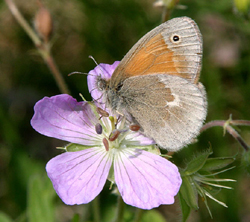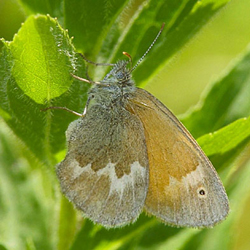Find a Butterfly
Common Ringlet
Coenonympha tullia
Named
Muller, 1764

Taxonomy & Nomenclature
Also: C. inornata Edwards, 1861; Prairie Ringlet, Inornate Ringlet; Large Heath (U.K.). The details of species and subspecies in the "tullia complex" have not been resolved. Some authorities name many species worldwide; others credit only one species, with numerous subspecies. We follow Ferris (1989), who lists a single species, with twenty one North American subspecies.
Identification
Wingspan: 1 1 7/8". Easily distinguished from other satyrs by pale orange and gray underside coloration and the single small eyespot (sometimes lacking) near the apex of forewing.
Distribution
Circumpolar. In Eurasia extending southward to Italy, the Balkans, central Asia, and Japan (Ferris and Brown). In North America, the species occurs from Alaska east to Newfoundland, and south to southern California, New Mexico, Nebraska, the northern Midwest, and southern New York. Widespread throughout New England.
Status in Massachusetts
Common Ringlets are recent colonizers of New England, having spread south from Canada. Holland (1931) noted the species‘ eastern range as "northern Ontario and Quebec to Labrador and Newfoundland." Common Ringlets were first found in Maine in 1968 (Opler and Krizek) and Massachusetts in 1978 (10 June, Groveland (Essex Co.), Mrs. Robert Busby). This butterfly is now abundant practically throughout the state (not yet recorded on Nantucket), becoming so in any given locality within a few years of its first appearance. Frequently found in colonies of 100+ individuals. Maximum: 1300, on 30 May 1993, Easton (Bristol Co.).

Flight Period in Massachusetts
Two flights, typically from late May to early July and late July to late August (no overlap of flights). Extreme dates: 15 May 1991, Millford (Worcester Co.), T. Dodd and 4 October 1994, Sudbury (Middlesex Co.), T. Dodd.
Larval Food Plants
Various grasses are reported from western populations, but no specifics are available for eastern Ringlets. Sedges have been reported from European races.
Adult Food sources
Opler and Krizek have no eastern nectaring records for this species, but state the Ringlet‘s preference for yellow composites in the West. There are records of twenty seven flowering plant species visited by Massachusetts Ringlets. They comprise thirteen families and have white (12), yellow (8), and pink/purple (7) flowers. No special nectaring preferences have been observed.

Habitat
Primarily open grassy areas at all elevations. Also, meadows with shrub growth and, occasionally, woodland roads.
Life Cycle
EGG: Pale green or yellowish; barrel shaped, with 36 vertical ribs. OVIPOSITION: Eggs laid singly on grasses or nearby objects. LARVA: Green, with lighter green lengthwise stripes and tan or green head. CHRYSALIS: Translucent brown or green, with some darker striping. OVERWINTERING STAGE: Larva. In late spring, overwintering larvae begin feeding again, and by late May/early June, adults, with their peculiar bouncing flight, are slowly coursing over grassy fields throughout much of the Commonwealth. Males keep up their mate seeking flights through the day, and both sexes visit flowers avidly, an unusual trait for a satyrid. Second brood larvae hibernate, apparently in any of the first four instar states.
Account Author
Brian Cassie



